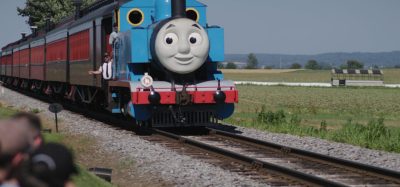Railion goes East
Posted: 2 March 2005 | | No comments yet
Observers in the logistics business, as well as in the media, have broadly interpreted the recent Railion strategy as an example of single-dimension expansion motivation. Such critics, however, have failed to perceive that the primary intention of Railion in this context is to develop international rail cargo transport throughout the relevant markets in such a way as to enhance competitiveness. At the same time, of course, Railion intends to secure and expand its own volume of business. The growing Eastern European transport market can serve as a prime example to illustrate the fact that Railion is pursuing a number of different approaches here, in accordance with the respective market constellations.
Observers in the logistics business, as well as in the media, have broadly interpreted the recent Railion strategy as an example of single-dimension expansion motivation. Such critics, however, have failed to perceive that the primary intention of Railion in this context is to develop international rail cargo transport throughout the relevant markets in such a way as to enhance competitiveness. At the same time, of course, Railion intends to secure and expand its own volume of business. The growing Eastern European transport market can serve as a prime example to illustrate the fact that Railion is pursuing a number of different approaches here, in accordance with the respective market constellations.
Observers in the logistics business, as well as in the media, have broadly interpreted the recent Railion strategy as an example of single-dimension expansion motivation.
Such critics, however, have failed to perceive that the primary intention of Railion in this context is to develop international rail cargo transport throughout the relevant markets in such a way as to enhance competitiveness. At the same time, of course, Railion intends to secure and expand its own volume of business. The growing Eastern European transport market can serve as a prime example to illustrate the fact that Railion is pursuing a number of different approaches here, in accordance with the respective market constellations.
Promising marketing potentials in Eastern Europe
Today, Railion does approximately 15% of its business with cargo transport to and from Central and Eastern European (MOE) countries. In 2003, Railion transport volume there reached approximately €380 million and 25 million metric tonnes. The explanation: the great transport distances in this region, as well as the still strong market position of Railion affiliated railway systems in Eastern Europe, means competitive advantages to rail transport there. In 2002 in the countries most important for Railion (for example Poland, the Czech Republic and Hungary), Railion enjoyed respective shares of 43%, 31%, and 29% in modal split: shares with falling tendency. The entire business involving cargo exchange with Eastern and South-Eastern Europe, furthermore, offers appreciable opportunities for growth. This freight business, after all, currently entails the movement of around 60 million metric tonnes per year – not including transit cargo flow through Germany. The latest figures, in addition, forecast a doubling of freight flow by 2015, with up to three times the current levels in some corridors. Railion’s objective here is to maintain its share of the market in this transport volume, and to expand in rail-affiliated segments.
Challenges presented by transport politics and corporate policies
This goal, however, presents Railion with challenges – not all of which can be responded to by the company itself. Present structural cargo conditions basically favour road vehicles, which, with their flexibility, are more effectively able to meet particular logistical requirements. On a demand-induced basis, therefore, a major share of traffic-transport growth will fall to truck traffic on roads and highways. A further element is the fact that politics in MOE countries are currently promoting the expansion of road and highway facilities considerably more vigorously than the likewise necessary expansion of rail infrastructure. Such short-sighted public transport policies will accordingly lead to mistakes that were made long ago in Western Europe after the Second World War. Consequently, this development will further disadvantage rail transport in its competitive position with respect to road transport. Eastern European truck carriers – in contrast to the rail companies of the region – are by now fully privatised, and have confronted not only regional rail companies, but also their Western European competition, with dumping prices. The constraints of state ownership, on the other hand, mean that the rail companies of MOE countries have not enjoyed sufficient corporate latitude, possibilities of development, or structural support.
Nevertheless, there are significant opportunities for rail businesses in all corridors in the region – business possibilities that Railion is in fact pursuing. A number of fundamental conditions do in fact contribute favourably, including the principle of ‘sustainable mobility’, as pursued by the subsidy policy of the European Union. The fundamental position of rail business, indeed, benefits from circumstances such as the following in MOE countries: roads and highways still unable to support heavy loads throughout much of Eastern and Central Europe, planned infrastructure tolls for trucks, as well as harmonisation of the legal framework in cargo traffic to EU requirements.
Differentiated Railion strategy
In order for Railion to succeed in its business in MOE countries, a primary requirement is to enhance the quality of international, long-haul transport activities. A second priority here is the implementation of production patterns that enable efficient bundling of cargo volume. Thirdly, new and attractive offerings on MOE corridors would enable Stinnes distribution to procure new transport business for Railion. At present, at any rate, the integration of MOE state rail cargo carriers into the Railion network (as with the Railion pattern for Denmark and The Netherlands) is not an immediate prospect. Requirements for rehabilitation and investment would overtax Railion resources. In addition, liberalisation of the rail sector has not attained sufficient progress in numerous MOE countries. Instead, strategic models involving ‘cooperation’ and ‘competition’ are under discussion: i.e. according to the strategic behaviour and the performance capability of the individual state cargo rail companies in MOE countries (see Figure 1). ‘Cooperation’ and ‘competition’ offer Railion the choice to take part in this region in private, newly organised rail transport companies, to fund its own such companies, and to exploit the possibilities of ‘open access’.
Cooperation: processes and technologies
For the stated reasons, nevertheless, Railion enjoys the prime opportunity of close collaboration with cargo rail companies still under state ownership: a key factor in maintaining existing transport business, and enhancing exploitation of market potentials as rapidly as possible. Such cooperative efforts are primarily intended to achieve noticeable improvements in transport quality for cargo customers within the short term, and to create new and competitive offerings. Business processes are of major significance here: i.e. harmonisation across the respective borders of production patterns, process monitoring, implementation of formalities involving customs and technical vehicle issues at the borders, as well as the flow of information accompanying the transport process.
There is no need to pretend that difficulties in such collaboration do not exist: e.g. frequently changing contacts at the companies involved, lack of implementation possibilities, linguistic barriers, meagre budgets, and frequently inadequate communications. Such difficulties indeed create tedious obstacles to the work of project participants.
A secondary objective is the deployment of multi-system locomotives and interlinked IT systems. The priority here is secondary, since the implementation of such systems generally demands investments at a level hardly possible for rail companies in MOE countries at present.
In the joint-venture projects, therefore, the immediate goals are development of transport activities in Eastern European systems, at a low level of investment, such that cargo customers can perceive obvious and appreciable improvements. In a number of cases, this has already been successful.
Example for South-East Europe – the ZEUS project
With the ZEUS project, Railion has approached improvements in this economic area – which includes Turkey. In a joint effort with Southern European cargo rail companies, this project is developing end-to-end rail transport chains as well as entirely new offerings. The Schenker subsidiary Railog has already succeeded in increasing the annual marketed volume in the Sopron-Ljubljana South Eastern European corridor from 600 to 1,800 full-train loads during the period from 1997 to 2003. Another successful example is the shortening of rail transport time from 13-24 hours to 10 hours, with an increase in capacity at the same time, along the axis connecting Munich North, Ljubljana and Zalog. Beginning at Ljubljana, cargo carriers can take advantage of connections to the Adriatic port of Koper, as well as links in the directions of Greece, Turkey, and the Balkan countries. Intensive efforts in ZEUS are also being conducted to achieve a non-stop connection of fewer than 100 hours between Germany and Turkey. The demonstration trip in May, with a multi-system locomotive and a transport time of 79 hours, attracted considerable attention in the media.
Outlook toward the East
Transport with the Czech Republic and Slovakia is dominated by high-growth and high-frequency transport with automotive and seaport-hinterland cargo. For Volkswagen and Continental, Railion – with marketing by Schenker – undertakes transport and logistics services for production plants in Bratislava, Mlada Boleslav and Puchov. These transports include pre-assembled bodies for the Porsche Cayenne, which proceed by rail to a plant in Leipzig. Many such transports take place from the evening of one day until delivery early the next morning: an advantage made possible by close cooperation with the Czech company CD Cargo. On the route from Dresden to Prague, many trains already operate without a change of locomotive or drivers.
In addition to Poland as the most important Eastern European market, a strategic orientation toward the East is especially important for Railion: in addition to the favourable long distances, the privatisation of the Russian company RZD offers the opportunity – by means of close collaboration – of rapidly expanding the currently small market share occupied by rail transport (2%). A joint venture with RZD will enable evaluation of possibilities to compete with sea transport of cargo from the Far East to Europe by offering rail transport. Rapidly developing Chinese railways, capacity reserves of 30% at Transsib, and planned rail transport times of less than 20 days (in comparison to around 40 days for ship cargo) are favourable aspects that contribute to a promising strategic starting position.







